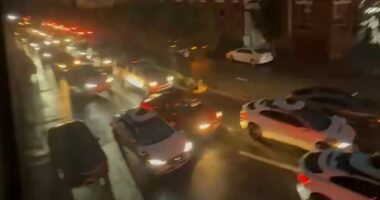Share this @internewscast.com
Coca-Cola’s latest holiday advertisement, crafted with artificial intelligence, aims to spread cheer but doesn’t quite hit the mark.
This week, the beverage company launched three new commercials as part of its 2025 holiday campaign.
However, sharp-eyed audiences quickly spotted several issues in one of the ads—a modern, AI-generated version of the classic 1995 “Holidays Are Coming” commercial. This AI homage is marred by noticeable glitches.
Upon closer inspection, viewers will observe that the famous red Coca-Cola trucks seem to morph in shape as they navigate the snowy road. Inconsistencies are also evident as the trucks appear to gain or lose wheels between scenes.
These wobbling Christmas trucks highlight a significant shortcoming in generative video models. Such systems often struggle to maintain consistency with characters and objects across different scenes.
This issue arises because many AI models generate videos frame by frame, without retaining memory of prior frames. This leads to what experts describe as ‘temporal drift’—a gradual loss of continuity across the video.
Some newer systems claim to have solved the issue, but Coca-Cola’s ad shows that the technology still isn’t quite ready for the big leagues.
‘There will be people who criticize — we cannot keep everyone 100 percent happy,’ Pratik Thakar, Coca-Cola’s global VP and head of generative AI, said in an interview with The Hollywood Reporter this week. ‘But if the majority of consumers see it in a positive way, it’s worth going forward.’

Coca-Cola just unveiled three ads as part of its 2025 holiday campaign

One of the commercials was an AI-generated remake of its infamous 1995 ‘Holidays are Coming’ ad

Coca-Cola President and CEO James Quincey
Indeed, there were people who criticized. Viewers rushed to the comments of the YouTube video to share their thoughts on the ad.
‘I really miss pre-AI internet,’ reads one comment under the YouTube video.
Another said, ‘real magic is when you hire an actual artist with a soul.’
‘I’ve never wanted a Pepsi so badly in my entire life,’ someone else joked.
‘Ah yes the holiday spirit of firing your employees to produce AI slop,’ one user wrote.
Coca-Cola announced plans to close down five production and distribution sites across the US in July — a plan that would cause 900 workers to lose their jobs, marking one of the company’s largest waves of domestic layoffs in recent decades.
The shutdowns were to affect sites in California, Florida, and Massachusetts, ranging from long-established bottling plants to regional distribution centers.
According to the company, each closure reflects a larger strategy focused on streamlining operations, increasing automation, and outsourcing segments of its supply chain to third-party bottlers.

Eagle-eyed soda-drinkers noticed that there were a series of glitches in the commercial due to AI mistakes

Coca-Cola faces the 25 percent tariff imposed on aluminum imports in March, as the company imports some of the aluminum used for its soda cans from Canada
Automation played a role in the layoffs, as did tariffs — especially on aluminum, which has pushed up the cost of cans.
Coca-Cola faces the 25 percent tariff imposed by President Donald Trump on aluminum imports in March, as the company imports some of the aluminum used for its soda cans from Canada.
However, Coca-Cola fared better than its number one rival Pepsi because it used ingredients used in US facilities.
Pepsi decided to make most of its concentrate — the sugary recipes that are then combined with water, bubbles and sweetener to make soda — in Ireland due to its low tax rate.
‘Ireland has long had the tax advantage—until the tariffs hit,’ HSBC analyst Carlos Laboy told the Wall Street Journal.

















